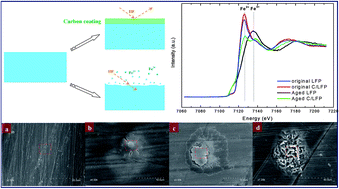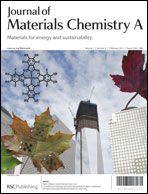Surface aging at olivine LiFePO4: a direct visual observation of iron dissolution and the protection role of nano-carbon coating
Abstract
LiFePO4 has attracted much attention as a potential cathode material for advanced lithium-ion batteries due to its superior thermal stability. In spite of this, LiFePO4 still suffers from fast capacity fading at high temperature and/or moisture-contaminated electrolyte. The influence of moisture and the detailed corrosion mechanism is still not clear. Here, for the first time, we present a direct visual observation of the surface corrosion process at olivine LiFePO4 stored in moisture-contaminated electrolyte, and found the direct relationship between iron dissolution and LiFePO4 corrosion. By using the LiFePO4 ingot sample with a flat surface as model materials, iron dissolution and surface chemistry change can be clearly observed and identified by field-emission scanning electron microscopy (SEM), time-of-flight-secondary ion mass spectroscopy (TOF-SIMS), and X-ray absorption near-edge structure (XANES). These iron dissolutions at some corrosion sites evoked the overall LiFePO4 surface corrosion. A significant improvement of the surface stability of LiFePO4 was obtained by nano-carbon coating, and the carbon surface layer protects LiFePO4 from direct contact with corrosive medium, effectively restraining the surface corrosion and preserving the initial surface chemistry of LiFePO4.


 Please wait while we load your content...
Please wait while we load your content...